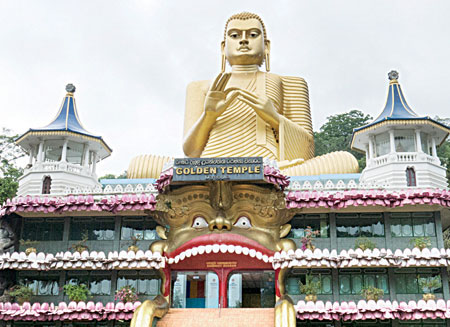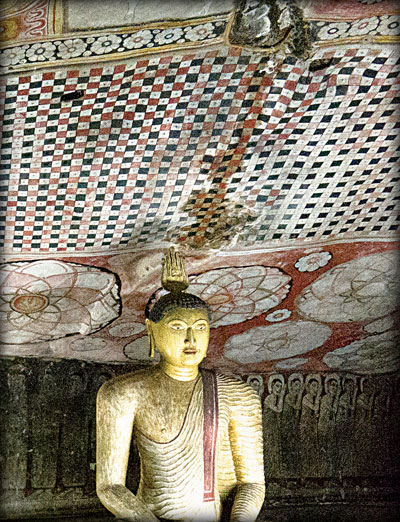|
Experts baffled by Dambulla’s ancient mystery… :
Upwardly flowing Water miracle no more? Paintings under threat
Story and photographs by Mahil Wijesinghe
 The
paintings depict episodes from the life of the Buddha, the defeat of
Maara (Death) and those connected with the introduction of Buddhism to
the country. These compositions are of excellent quality and are among
the masterpieces of Sinhala temple art The
paintings depict episodes from the life of the Buddha, the defeat of
Maara (Death) and those connected with the introduction of Buddhism to
the country. These compositions are of excellent quality and are among
the masterpieces of Sinhala temple art
The legendary ‘upwardly flowing’ water stream that then drips from
the rock roof of the main cave in Dambulla’s ancient rock temple now
appears to have stopped its regular flow baffling experts and believers
alike. Some of the faithful who pilgrimage to this historic temple view
the sudden interruption of the flow as an ill omen.
The beautiful, ancient paintings in the series of rock caves on top
of the Dambula rock are internationally admired and are the reason for
Dambulla to be classified by UNESCO as an UN Heritage Site. But for Sri
Lankans, an equally important and intriguing attraction is the stream of
water that seemingly runs upwards, defying gravity, along the roof of
the main temple cave and then drips into a large bowl placed on the
floor to collect the water which is considered sacred by many believers.
The upwardly flowing stream is the source of legend and is believed
to have flowed miraculously un-interrupted for centuries in drought and
in the rainy seasons. Some local people claim that it had been a
permanent feature and had never dried up.
Measured
The water enters the cave near one wall, then, seems to defy gravity
and flow upward along a fissure in the ceiling before falling in
measured drops into a large bowl placed beneath. The effect might be
explained away as an optical illusion, except that no one knows why the
rate of flow always remained constant, even in times of prolonged
drought. Besides, the cave itself is located 600 feet up the side of the
rock, just below the tree line at a level of moisture-retaining
vegetation.
|

The Golden Temple of Dambulla, newly added construction to
the historic site |
In the recent past, a number of investigations have been carried out
to solve the mystery. These included independent studies by an Italian
expert group sometime back in 1980. They have spent four months camped
atop the rock, taking measurements, running dye tests to track the
stream and, exploring man-made drip ledges and natural cracks in the
rock for hidden pools.
But no explanation has emerged from these investigations, except that
it was clear that the flow was un-interrupted. The water is used only
for sacred purposes.
When I visited the cave several years back, I saw water falling in
steady drops into the bowl. However, today, the miraculously flowing
water has stopped streaming upwards along the roof of the cave and
dripping to the floor. Instead, the seepage of water can be seen
elsewhere in the ceiling of the cave today and this spreading moisture
now threaten the priceless, ancient, paintings that adorn the roof and
sides of the cave.
Walking around the Dambulla cave temple, North Central Province, I
almost felt like I was entering a gallery of medieval art and
sculptures.
Located on a 6oo foot high rocky outcrop, the rock cave temple of
Dambulla consists of five continuous caves whose entire ceiling and wall
surface is covered by paintings and painted Buddha statues. It has a
staggering 20,000 square feet of paintings which put it on the map of
World Heritage Sites.
The rock cave complexes of Dambulla belong to two important periods
in Sri Lanka’s history: the troubled times of King Valagamba in the
first century BC when the cave shrine was first created, and again the
18th century reign of King Kirti Sri Rajasingha who presided over a
renaissance of culture and religion in Sri Lanka including renovation
and restoration of Dambulla.
On the slope of the rock there is a new construction of a massive
temple complex and a gold colour Buddha statue called the ‘Golden Temple
of Dambulla’
However, according to the recent news reports the priceless paintings
and statues of the rock cave temple of Dambulla are in danger due to
roof leaks, poor maintenance and termite attacks on Buddha statues. It
is a matter of serious concern that the archaeological remains of the
rock cave temple including paintings and statues have been left to the
mercy of the elements. I found the site poorly maintained.
Raised
|

The water leaking from the rock ceiling is damaging the
paintings |
Matters got worse when the UNESCO Director-General Irina Bokova said
she raised the maintenance issue of the rock cave temple of Dambulla
with local authorities during her visit to the site last month. The
UNESCO Director-General has stressed that the Government is bound by
international obligations to protect the cave temple which is home to
2,000-year-old paintings and 157 Buddha statues, although she pointed
out that the site was no in danger of losing its World Heritage status.
Whatever the issues are, it is a prime responsibility of the
authorities to protect and conserve the priceless heritage site for
future posterity. Actually, the paintings and statues of the rock cave
temple of Dambulla have been allowed to perish due to negligence.
The main cave is identified as Maha Raja Viharaya. The paintings
depict episodes from the life of the Buddha, the defeat of Maara (Death)
and those connected with the introduction of Buddhism to the country.
These compositions are of excellent quality and are among the
masterpieces of Sinhala temple art.
The 18th century paintings are considered the most important heritage
of Dambulla. They spread over five caves and the restoration of these
rock cave paintings was carried out by a dynasty of highly skilled
artists and specialist temple painters residing in the rural village of
Nilagama in Kandy. The last figure of this vanishing generation was late
Jeevan Naide who did most of the restoration of paintings in Dambulla
caves.
Attitudes
Inside the dimly lit caves, foreign tourists walk freely as if they
are strolling in an art gallery. Some foreign tourists’ attitudes are
probably a direct threat to the Buddha statues. Some tourists from Asian
countries worship the statues by sticking or pasting pieces square
stickers to the statues, which can harm the statues. The intricately
drawn paintings which depict the Buddha’s life and beautiful floral
motifs have been drawn on the rocky surface of the rock ceiling. These
paintings are disfigured in the areas where water is leaking.
Another danger to the paintings is the very antiquity of the site.
The centuries old paintings and statues are discoloured and need to be
repainted. But the generations of artists who painted these are gone and
there is no one to replace them.
The rock cave of Dambulla is acknowledged as the most spectacular of
cave temples of Sri Lanka.
However, if an urgent solution is not found to the problems affecting
the Dambulla cave temple, the centuries old exotic legacy of the
Dambulla paintings might be lost forever. |

